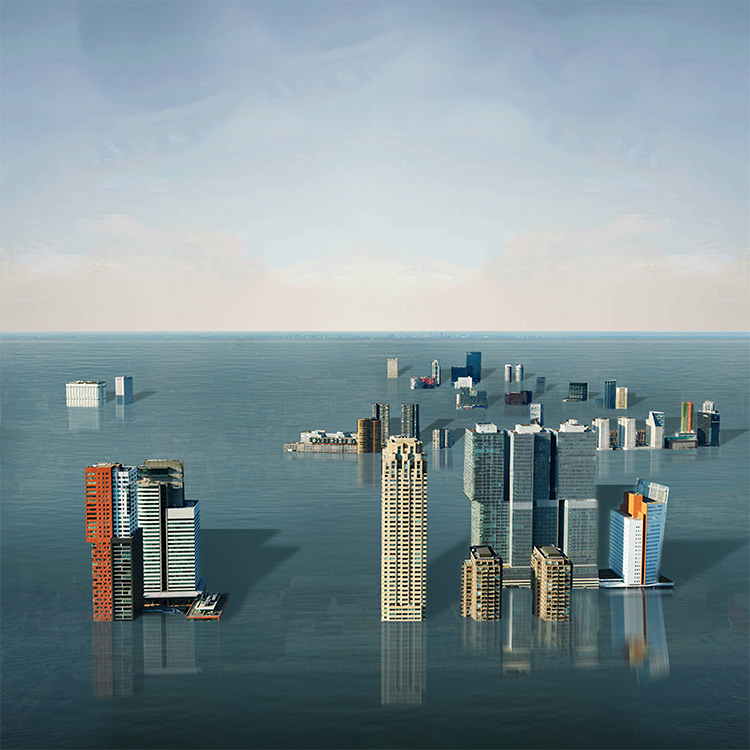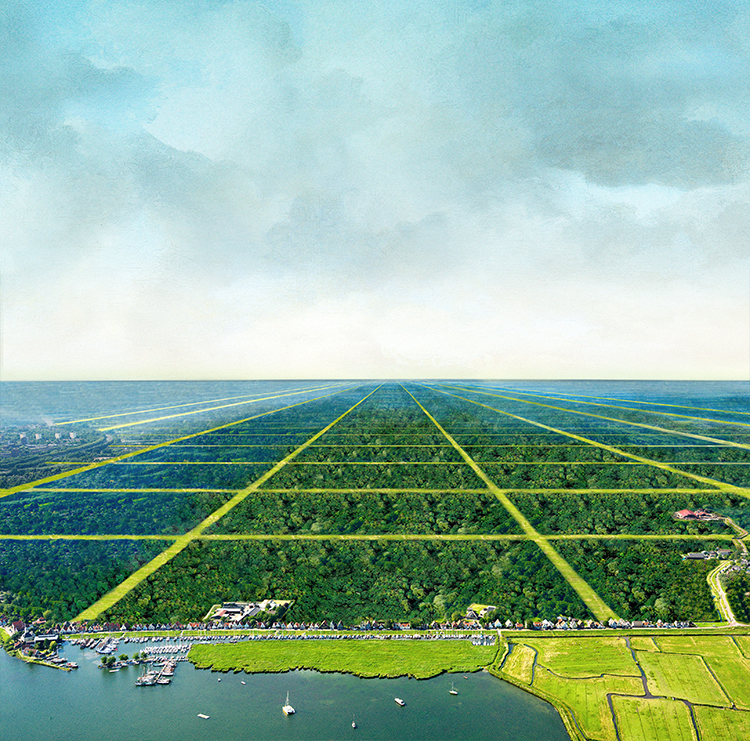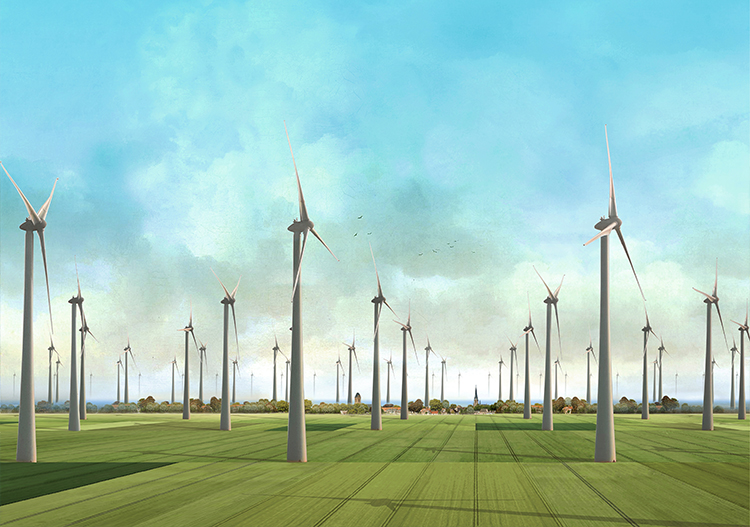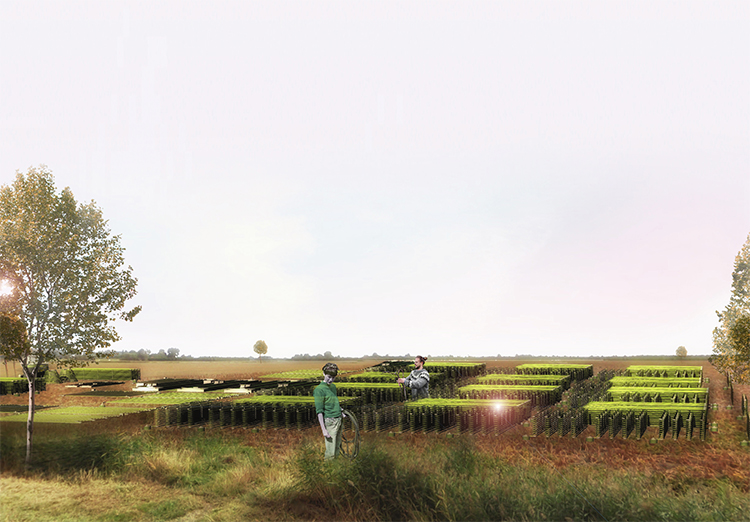
The Power of Envisioning: Projective design as a tool for embracing radical change
– Aikaterina Myserli and Henk Hartzema
During the summer of 2019, the National Environmental Vision (De Nationale Omgevingsvisie-NOVI), was published in the Netherlands. For the first time in planning history, the Netherlands got a full-scale vision, not just for infrastructure or land use, but for the entire living environment. The vision highlighted a common interest for businesses, governments, academia and civil society: the quality of the environment. At the same time however, NOVI still hesitates to address the confrontation between the comfortable, pre-existing structures (fossil fuel dependence, high CO2 emissions etc.) and the extent of change of Dutch cities and landscape (nitrogen crisis, shortage of housing etc.). Based on this observation, this paper investigates how design-led approaches can allow different stakeholders to see the bigger picture, embrace change and contribute to the active implementation of strategic visions. Focusing on the Randstad region, the authors draw inspiration from the work of Superstudio and use extreme –and sometimes dystopian–- scenarios of large-scale change as a snapshot of a potential future. Building upon their experience with projective visions and research-by-design, they indicate how the implementation of strategic visions like the NOVI can be enhanced by practices that leverage imagination, creativity and data-driven experimentation.
In the light of challenging conditions, expected household growth and an unavoidable climate crisis, various forms of planning and self-organization through municipal initiatives and provincial agendas have emerged in the Netherlands. For lack of a coherent framework on a high-level, all these approaches still fail to provide a clear vision for the future. In fact, the Netherlands has gradually moved from the late 1960s’ highly ambitious versions of national plans towards an era of weakened national spatial planning and uncoordinated interventions on a local scale. The only moment in recent years when the Netherlands experienced a highly coordinated action of centralized planning was after the North Sea Flood of 1953. According to data from Rijkswaterstaat1, the flood claimed the lives of 1,836 people, more than 72,000 people were evacuated and 47,000 cattle and 140,000 poultry drowned. In addition, more than 150,000 hectares of land were inundated causing severe damage to infrastructure and farmland. In view of this national disaster, the Rijkswaterstaat initiated the construction of the Delta Works the following year.
In 2013 the Delta Works was voted the most prestigious hydraulic engineering project in the world2 and continue to lead by example in the field of flood-defense systems today. The question is, what we can learn from the North Sea Flood and the direct response of Delta Works today? Is it valid to say that we need a natural disaster in order to shift the mindset towards planning and risk prevention? Would the Rijkswaterstaat have done the same without the North Sea Flood disaster? The conventional wisdom says no. In fact, every natural disaster is a policy disaster in its own way. A recent article of the NRC3 on the Maas flood in Maastricht 25 years ago mentioned how victims would have preferred a series of dikes similar to the Delta Works than the reports on adaptive planning and design with nature that usually fall short when the disaster happens. This observation makes it evident that there is a gap between the current fragmented local planning initiatives in the Netherlands and an authoritarian national plan like the ones of the 60s.
Beyond the NOVI
Now that the Netherlands is on the brink of major spatial changes prompted by the rapidly growing cities, climate crisis and energy transition, it may be worthwhile to examine the national mechanisms of planning. During the summer of 2019, the Draft National Environmental Vision (De Nationale Omgevingsvisie-NOVI) was published. For the first time in history, the Netherlands got a full-scale plan, not just for infrastructure or land use, but a vision of the entire living environment. As advertised in its executive summary “this strategy document will enable us to respond to the major challenges facing us.[…] Combining all those challenges calls for a new approach, not imposed from above, but drawn up in careful consultation between government authorities, businesses, centres of knowledge, civil society organisations and individual citizens. The NOVI offers a framework, suggests a route to be followed and, wherever possible, to makes choices.”4
The special feature of the NOVI compared to previous spatial visions is that it tries to grasp the integrality of elements that together determine the design of the Netherlands. It recognises that in this complex country everything is connected with everything. Chief Government Architect Floris van Alkemade also emphasizes these aspects in his Panorama Nederland5 and finds a lot of resonance with this. It is the first time that a vision document highlights a common interest for businesses, governments, academia and civil society: the quality of the environment. At the same time however, NOVI still hesitates to address the confrontation between the comfortable, pre-existing structures (fossil fuel dependence, high CO2 emissions etc.) and the extent of change in Dutch cities and landscape (nitrogen crisis, shortage of housing etc.)- which is both inevitable and confusing.
It is therefore both a hopeful fact and an unstable construct. Hopeful because frameworks are offered on a national scale and processes are set in motion. It provides guidance on how to properly organize changes and addresses a wide spectrum of stakeholders and layers of society. At the same time, it appears to be rather shaky because it is instrumental and without strong spatial imagination to help make those choices. Its extremely wide stakeholders’ spectrum is making it difficult to prioritize which challenges should be addressed on the short term too. Somewhere in-between decentralized spatial agendas and strong national planning guidelines, like the Delta Works, the NOVI still asks for future images, calls for change and illustrations of the “bigger picture”.
Envisioning change
We do not believe that a reversal of our architecture and planning tradition is possible, certainly not in the short term. But we think that visions of the future can help see the bigger picture sooner. What is missing from the NOVI is embracing change and envisioning the future of the Netherlands in spatial terms – not just in vague policies and bullet points. Leveraging imagination as a tool to visualize the future of our cities and landscapes might be the final ingredient to a new national plan. Being a polycentric metropolis a priori, the Randstad serves as a great test bed for this. Separated into various administrative entities, it calls for the re-evaluation of the problematic links between local communities, municipalities and provinces and for a direction that will unite all these disparate actors. The same way Superstudio used the Continuous Monument6 to envision a world rendered uniform by mass culture and technology, we aim at using extreme –and sometimes dystopian– scenarios of large-scale change as a snapshot of a potential future.
A case in point could be flooding the Randstad in the next 80 years [Images1.-5.]. Rather than wanting to desperately restore the conservative structures of flood defense, polders and dike rings, we could let the Maas further submerge the low-lands and make almost half of the country a natural Delta. This would create a system of aquatic resort towns –which is not far from what Amsterdam has been turned to the last decade. Similarly, in another envisaged flooded scenario, sacred buildings in the Randstad, being the tallest and most resilient, have been appropriated by technological devices. Telecom towers are paired with cathedral tops and parabolic plates take over churches with domes. The scenario addresses the rise and final stabilization of the sea level as the definitive step for rethinking our –former– places of worship. The “robotization” of our sacred buildings will destabilize their status quo and will make them active and accessible instruments against a climate catastrophe. Likewise, a gigantic power storage hole in the middle of Zeeland might be the future of our energy transition. Or, the large-scale appropriation and conversion of Randstad’s neutral space into vast forests or arrays of wind turbines could also set the foundations for designing energy transition, raising awareness and, most importantly, helping contemporary societies embrace radical change. By leveraging imagination as a tool for data-driven experimentation and scaled-up thinking, our future becomes tangible and familiar. Through the psychological rethinking of the Dutch territory as a field of experimentation and not as a settled field of rules and spatial configurations we might be able to see the bigger picture and embrace a radical future.
Inhabiting the sphere of the imaginary can be a way to reflect on the aftermath of our current socio-spatial actions and what will be the future if we do not act and design the transition soon. What strongly characterizes the postmodern era is a nostalgia that drives us towards an illusory flight to the imaginary, to the dream of community and the lost common soul. The related loss of any collectivity, the sense of the uncanny, the rise of individualism, consumerism and mass culture of virtual communication systems are some of the characteristics inherited in the 21st century from the 20th. In the introduction of ”The poetics of space”, Bachelard examines a mental capacity almost identical to the one that runs through the works of Heidegger: The poetic imagination7.
In this psychological exercise, no moralism or skepticism is needed. As architects, urban planners, researchers and designers we should embrace imagination as a key instrument in our arsenal of tools towards contemporary urban issues and challenges. In such a condition, experimental planning and architecture has a dual role: (i) to convey the meanings and functions of the community, and (ii) to derive needs, values and expectations from this community. This role evolves through the process of spatial composition and produces space in harmony with both the environment and the place. The value of the collective spirit expresses the urgent need for public space as a common good of the whole community. The poetic geography of the flooded or repurposed Dutch landscape serves for a while as a fictional field of shared principles, goals, ideas, world views and moral values and could consequently provide a proportion of programs and functions for the real space. The concept of the imaginative scenario will no longer be a subjective picture, but to the extent that it is based on shared thoughts, concepts and planning conditions of the place, it could enhance the design of the collective public space of the city with meanings, ideas and values.
So, one could reasonably ask how can we recouple poetic imagination with highly functional city visions? Fortunately, research and design projects from both academia and contemporary Dutch practice have laid the foundations for this approach. The recent work of TU Delft’s interdisciplinary studio Transitional Territories8, under the guidance of Taneha Bacchin, has delivered tangible, yet highly visionary solutions for the future of the North Sea, with a specific emphasis on the Randstad. Some of its research and design projects revolve around repurposing entire territories of polluted grasslands and introducing sustainable aquaculture and algae crops in the Dutch-Flemish Delta9 [Image 6.] or developing new forms of re-engagement with soil, water and air as tools for ecosystem-based production in the Dutch Rivierenland area10. Similarly, the recent project of the Deltametropolis Association “The New Planning”11 has successfully connected theory to practice (and vice versa) by co-creating a list of approaches and working methods that can be inspiring for everyone and put a specific emphasis on instrumentalizing projective design and creative narratives for NOVI’s spatial challenges.
In general, contemporary Dutch cities no longer need absolute answers to the question of production or ecological transformation but an understanding of resilience to potential shocks. The recent COVID-19 pandemic shed additional light on this perspective. For our community of architects, urban planners and researchers, leveraging poetic imagination and projective design could serve as a means to introduce uncertainty and innovation into current socio-spatial models. To achieve this, further research on the role of imaginative scenarios for designing with uncertainty and adaptation would be useful. Finally, more methodological work on storytelling techniques and creation of appealing visual content could prove beneficial for illustrating planetary urgencies and achieving the gradual engagement of the general public.
Conclusion
The Randstad has yet to experience this kind of paradigm shift, both in planning as well as in policy making and development of environmental strategies. Divided into different administrative entities and governance boundaries, it often suffers from lack of coordination between different sectors and asks for more integrated strategies between the various stakeholders. Similarly, the global upscaling of socio-metabolic processes will also require cooperation and planning on a high level. Without a united vision and direction towards singular metabolism –to the extent that this is possible– we will find ourselves unable to cope with climate change. And this will inevitably have serious boomerang effects on our current socio-economic backbone.
The recent publication of the NOVI in the Netherlands steadfastly adhered to suggestive policy’s potential to reform and rebuild society through advanced technological apparatuses (such as extensive flood defence, wind and solar energy generation etc.), without taking any clear position on how these changes will look like or take place. The eagerness of the practitioners regarding the ongoing discussion about the NOVI and the changing systems coping with the transitions in spatial planning led us to initiate the discussion on imaginative planning and the power of envisioning.
We do not see larger scale visions, extreme scenarios and megastructures as an architecture or urban planning panacea. In current design practice in the Netherlands, one group after another start seeing in the large-scale visions the ability to provide an ‘open’ framework for planning that still dictates the broader means by which its residents respond to and inhabit the landscape. Echoing the argumentation of Superstudio, resorting to the poetics of experimental scenarios and large-scale visions appears to be the only way to draw and enrich a wide variety of stories related to architecture and spatial planning systems. This obviously doesn’t imply that we need to adopt those scenarios or –even worse– to go back to the highly deterministic national plans of the 1960s. We no longer belong to the era representing a top-down, technocratic view of design and the authoritarian role of the designer as master planner. We are simply reminded to reflect on the potential consequences of a climate catastrophe and take a brave position towards an uncertain future.

Image 1. Rotterdam in 2100. Source: Studio Hartzema & FRESH. Rotterdam, 2019.

Image 2. Delft flooded in 2100. Source: Studio Hartzema & FRESH. Rotterdam, 2020.

Image 3. Power storage in Zeeland in 2080. Source: Studio Hartzema & FRESH. Rotterdam, 2019.

Image 4. Afforestation in Durgerdam in 2050. Source: Studio Hartzema & FRESH. Rotterdam, 2019.

Image 5. Wind farm in Oudewater in 2050. Source: Studio Hartzema & FRESH. Rotterdam, 2019.

Image 6. Re-Natured Economy: Algae-based crops in the Dutch-Flemish Delta in 2050. Source: Courtesy of the author. TU Delft, 2018.
Notes
1. For more information on the North Sea Flood, see: https://www.rijkswaterstaat.nl/english/water/water-safety/the-flood-of-1953/index.aspx
2. Ibid.
3. Fortuin, A. (2020). Jullie hebben de Deltawerken, maar zo’n riviertje als de Maas krijgen jullie niet in bedwang, NRC [online]. Available at: https://www.nrc.nl/nieuws/2020/02/04/de-kuren-van-de-maas-25-jaar-later-a3989183 (Accessed on February 4, 2020).
4. For more information on the NOVI, see here: https://denationaleomgevingsvisie.nl/default.aspx
5. Source: https://www.collegevanrijksadviseurs.nl/projecten/panorama-nederland
6. Lang, P., Menking, W. (Eds.) (2003) [1971]. Superstudio: Life without objects. Milano: Skira.
7. Bachelard, G. (1969). The poetics of space. Massachusetts: Beacon Press.
8. See more here: https://deltaurbanism.org/
9. Myserli, A. (2018). Re-Natured Economy: From pollutants to productive landscapes. Master thesis, Delft University of Technology, Delft. http://resolver.tudelft.nl/uuid:83482dfd-05e3-496f-aa31-194f95849ceb
10. Recubenis Sanchis, I. (2020). Restoring Systemic Proximities: Towards the re-territorialization of the Dutch Rivierenland. Master thesis, Delft University of Technology, Delft. http://resolver.tudelft.nl/uuid:2d79ab24-9ac8-4b1f-8bca-ed4eeb999e71
11. See more here: https://deltametropool.nl/projecten/the-new-planning/
Aikaterina Myserli is an architect & urban planner at the Rotterdam-based firm Studio Hartzema and, since 2019, she is parallelly co-leading the firm’s research department FRESH Research. In 2020, she was additionally appointed as guest researcher at the TU Delft Department of Urbanism. Before joining the studio, she had been working in the fields of architecture, urbanism and sustainability consulting in Greece (IPS, Acqua-Tech), Argentina (Buenos Aires City Government) and China (Hangzhou 2022 Asian Games). In 2018, she was selected as one of the Top 100 Leaders of Tomorrow, representing the field of AI and Urbanism, in St. Gallen, Switzerland. She holds a BSc and Msc (Hons) in Architecture and Engineering from Aristotle University of Thessaloniki and a MSc (Hons) in Urbanism from TU Delft.
Henk Hartzema is a Dutch architect and urban planner. Up to 2002, he was partner at West8 and in 2005 he founded Studio Hartzema. In 2019, he established the studio’s research department FRESH Research. He has been involved in a large number of tasks of urban restructuring and master planning, such as the Leiden Bio Science Park, the VU Campus Amsterdam and the Plaspoelpolder in Rijswijk. Alongside his work as a practitioner, he has been associated with universities and colleges in the Netherlands and abroad for more than 20 years, including TU Delft (NL), the Academy of Architecture in Amsterdam (NL) and University of Mendrisio (CH).
Volume 4, no. 1 Spring 2021
